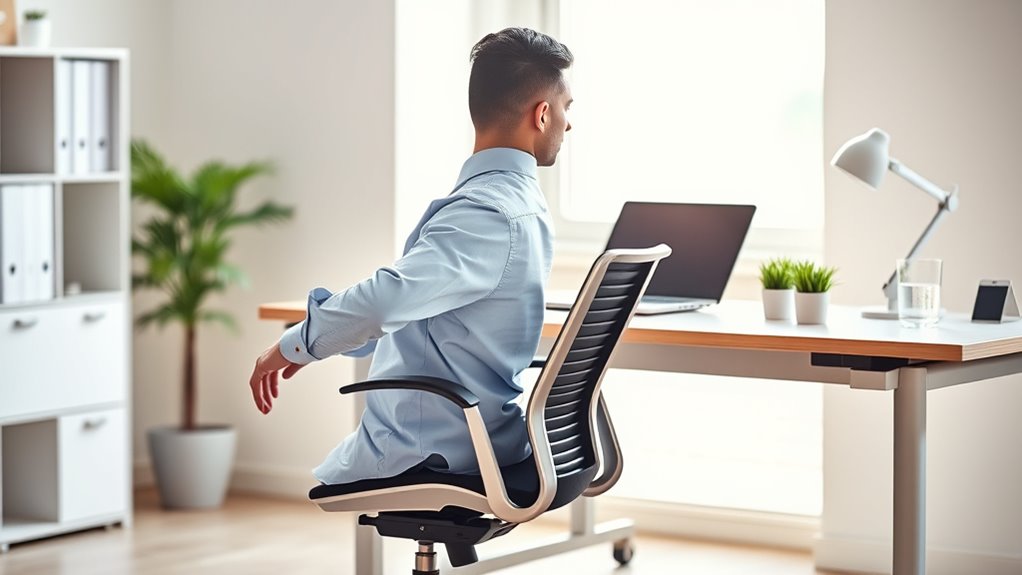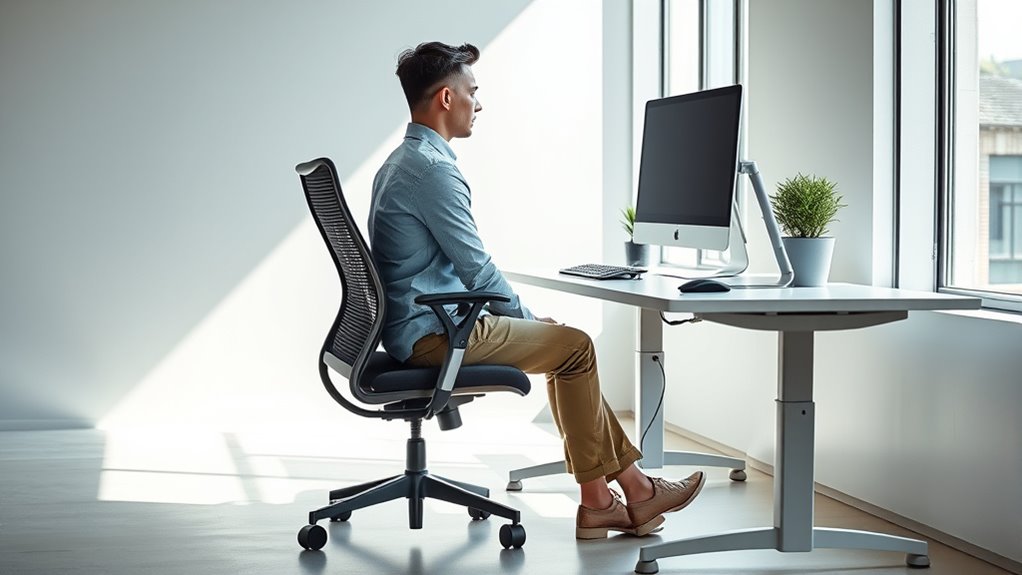To stop slouching at your desk, start with ergonomic accessories like adjustable chairs and sit-stand desks to support good posture. Take short breaks every 30 to 60 minutes to stretch your neck, shoulders, and back, which releases tension and keeps muscles relaxed. Stay mindful of your body position and make small adjustments throughout the day. Keep these tips in mind, and you’ll discover more simple strategies to improve your comfort and posture longer-term.
Key Takeaways
- Use ergonomic chairs and sit-stand desks to promote upright posture and reduce slouching.
- Take regular breaks every 30-60 minutes to stretch neck, shoulders, and back.
- Keep wrists in neutral positions with ergonomic keyboard and mouse setups.
- Maintain awareness of your body position and make small adjustments throughout the day.
- Incorporate simple stretching routines to relieve tension and support spinal alignment.

If you spend long hours at a desk, maintaining good posture can prevent discomfort and long-term injuries. One of the most effective ways to do this is by using ergonomic accessories. These tools are designed to support your body’s natural alignment and reduce strain. For example, an ergonomic chair with adjustable height and lumbar support encourages you to sit upright, alleviating pressure on your lower back. A sit-stand desk allows you to alternate between sitting and standing, which can decrease stiffness and improve circulation. Keyboard and mouse ergonomic designs help keep your wrists in a neutral position, preventing repetitive strain injuries. Incorporating these accessories into your workspace doesn’t require a complete overhaul; even small adjustments can make a significant difference in how you feel after a long day.
Beyond ergonomic accessories, developing consistent stretching routines plays a vital role in maintaining good posture. Every hour, take a few minutes to stretch your neck, shoulders, back, and arms. Simple stretches, like gently pulling your head to each side to stretch your neck or rolling your shoulders backward, can release tension accumulated from prolonged sitting. Stretching routines help improve flexibility, reduce muscle tightness, and prevent postural habits that lead to slouching. Keeping your muscles relaxed and elongated supports proper spinal alignment and reduces fatigue. Making it a habit to stand up, stretch, and move around regularly—preferably every 30 to 60 minutes—is also essential for managing irregular income for freelancers and preventing the development of chronic pain or repetitive strain injuries that can stem from poor posture habits. Staying mindful of your body’s position and making small, consistent adjustments throughout the day can lead to lasting improvements.
Regular stretching every hour boosts flexibility, reduces tension, and keeps your posture aligned and comfortable.
In short, prioritizing ergonomic accessories and stretching routines is essential for preventing the slouch and maintaining good posture. These habits are easy to implement, cost-effective, and highly beneficial. Over time, you’ll notice less discomfort, increased energy, and a more confident, upright stance. Remember, good posture isn’t a one-time fix—it’s a continuous practice that keeps you comfortable and healthy during those long hours at your desk.
Frequently Asked Questions
How Often Should I Take Posture Breaks During Work?
You should take a posture break every 30 to 60 minutes during work. Using ergonomic accessories like adjustable chairs and keyboard supports can help maintain good posture. Additionally, posture tracking apps or devices remind you to correct your position regularly. These breaks prevent strain, reduce discomfort, and improve focus. By consistently resetting your posture, you’ll avoid slouching and promote better spinal health throughout your workday.
Are There Specific Exercises to Strengthen My Back Muscles?
Think of your back muscles as the sturdy roots of a tree. To keep your tree healthy and upright, you need to do core strengthening and back muscle exercises. Try exercises like rows, back extensions, and planks regularly. These strengthen your back, improve posture, and prevent slouching. Incorporate them into your routine, and you’ll notice a stronger, more balanced you, standing tall like a resilient tree.
Can Ergonomic Chairs Alone Improve My Posture?
You might think ergonomic chairs alone fix posture, but that’s a myth. They help, but don’t rely solely on them. Combine ergonomic chairs with posture correction devices and habits like regular breaks and stretches. Ergonomic chair myths often lead people to believe they’re enough, but true improvement comes from a all-encompassing approach. Use these tools together to support your spine and maintain better posture throughout your workday.
What Signs Indicate I Need to Correct My Posture?
Imagine noticing your shoulders creeping up near your ears or feeling a persistent ache in your neck after long screen time. These signs mean you need to correct your posture. If tech gadgets and ergonomic accessories aren’t helping, it’s time to pay attention. Your body signals when it’s out of alignment—tight muscles, headaches, or fatigue indicate you should adjust your sitting habits and incorporate posture-friendly routines.
How Can I Maintain Good Posture When Standing or Walking?
To maintain good posture when standing or walking, focus on your footwear choices—wear supportive shoes that keep your spine aligned. Keep your shoulders relaxed, chest open, and engage your core. When walking, take even steps and avoid leaning forward or backward. Pay attention to your walking posture regularly, and adjust as needed. Proper footwear and mindful movement help prevent strain and promote healthy, upright posture throughout your day.
Conclusion
Imagine your spine as a sturdy, graceful column supporting you through each workday. By applying these simple posture hacks, you’ll prevent it from buckling under stress, standing tall like a lighthouse guiding your way. Keep your shoulders relaxed, your feet grounded, and your monitor at eye level. With these small changes, you’ll feel the difference—less strain, more energy—so you can sail smoothly through your tasks, confident in your strong, upright posture.









